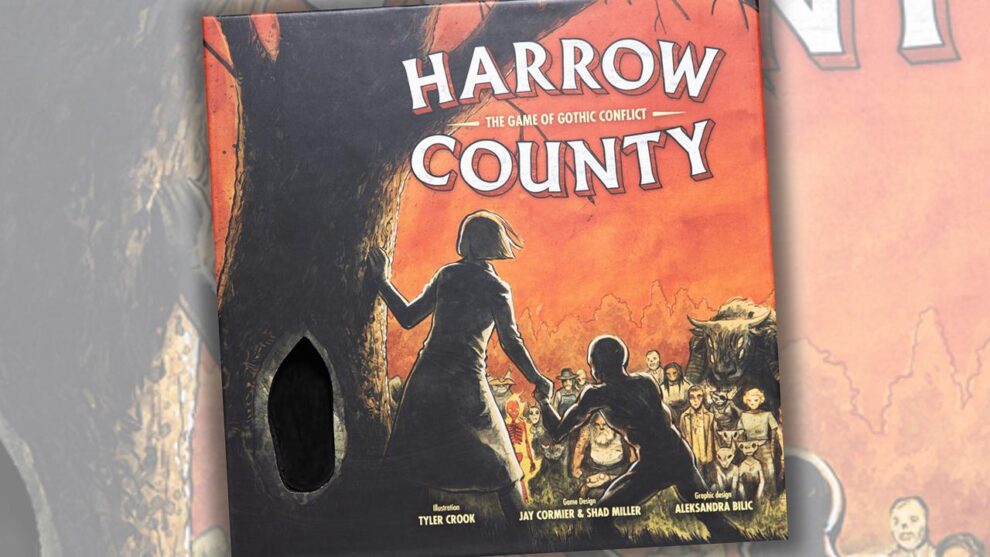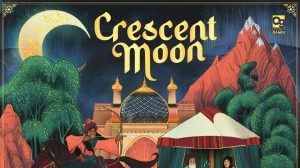Disclosure: Meeple Mountain received a free copy of this product in exchange for an honest, unbiased review. This review is not intended to be an endorsement.
At Gen Con 2023, I had the chance to sit down with Jay Cormier, the designer of Mind MGMT: The Psychic Espionage “Game.” His studio, Off the Page Games, had a couple new games coming to market in the months ahead, so he invited our team to join him at a demo table to run through the new offerings.
Jay talks a lot like I do—fast, excitedly, directly. He also has purple hair, which I might have done were it not for the fact that I don’t have hair any more.
Jay showed me two games that night: Corps of Discovery: A Game Set in the World of Manifest Destiny, and Harrow County: The Game of Gothic Conflict. Both games stand out in the same way Mind MGMT did, because the productions are beautiful and based—like all Off the Page Games products—on existing IP from the world of creator-owned comic books.
Harrow County’s world was unknown to me prior to playing the game. According to this Wikipedia page, the stories of Harrow County were first told by creators Cullen Bunn and Tyler Crookborn in 2015, first via prose on Bunn’s personal website before turning into a comic around the same time. The game world is rich, so one must assume that the comic source material (published by Dark Horse) is even more detailed, with dozens of editions available for the comic horror enthusiasts in the marketplace.
As a game, Harrow County is exceptional. I am really pleased with the level of depth for a game that looks so simple, and the production is incredible, right down to little green snake pieces that signify an infected follower working with a dead witch. (No, Harrow County is not for young children.)

One, Two, Three (Players)
Harrow County is an asymmetrical skirmish and route-building game with a small taste of “king of the hill” scoring for two players, with a variant for solo players as well as a three-player option. The best way to play it features the use of two of the three main factions from the world of the comics: the Protectors, the Family, or Kammi, the twin sister of the woman who leads the Protectors.
There’s also a witch named Hester that was burned, hung, then buried underneath the big tree in town that sets off the events of the main story. Hester can be played in solo games of Harrow County, as well as a three-player variant where Hester is trying to eat the leaders of the other two player factions to win. (Again, Harrow County…not for kids.)
The leaders of the Protectors (the good guys) and the Family (the members of Hester’s family who want to burn Harrow County to the ground) are represented by a single pawn on a small map, and there’s a lot of variety out of the box for each of those two factions, with 11 leaders available across the Protectors and the Family.
The third main faction is represented by Kammi, who was born at the same time as Emmy but was then whisked off to New York City, away from a life in Harrow County. Raised to be “devious and cruel”, per the manual, Kammi’s goal is a bit different than the other factions—to find a rag doll that contains her life essence, the key to unleashing the power needed to take over the County. This faction is offered as a third option after players learn the ins and outs of the Protectors and the Family.
So, as you can tell, just sitting down at the table to figure out who you want to play, why you want to play them, and understanding the game mechanics is a rich experience. Harrow County aces the worldbuilding test with a rulebook that doubles as an introduction to the comics, although the rules could use a little trimming since the game isn’t as complex as its 40-page rulebook would suggest.
The game itself is straightforward—the first player to reach seven or more points triggers the end game, then the player with the most points wins. Points pile up in three areas: killing off “haints” (controllable spirits which acts as low-level grunts for each faction), completing a faction’s main scoring objectives (saving townsfolk, destroying buildings, or finding the “real” rag doll if Kammi is in play), and holding the space in the middle of the game map, known as the Brambles. In my experience (three plays), solo and two-player games take about 30-45 minutes, just like it says on the side of the box.

Deep and Dark
I don’t usually take issue with a game’s “complexity rating” on the BoardGameGeek website, but Harrow County is an exception…the rating there (a 4.00 out of 5.00) is way too high.
I say that because the game is fairly easy to teach, even to those who don’t play a lot of games. The game’s rulebook takes care to teach the main mechanics to new players, but nothing about the structure of turns or rounds struck me as highly complex. I do think that early mistakes can lead to game-breaking failures, though this is mitigated by a very reasonable playtime.
I’m starting with the complexity rating because it is counter to how I feel about Harrow County—it is delightfully accessible for a two-player, head-to-head combat game. Movement rules are easy, as players move around the small hexagonal map to gather tokens that strengthen the four main actions in the game (Advance, Spawn, Strengthen, Legend).
Combat is really simple: drop a bunch of cubes from the “Battleground” into a tower built into the game’s box, and after a couple cubes are intentionally caught in the tower (who doesn’t love drama?), whoever has more cubes come out wins the combat as long as they have enough cubes to pay for each opponent’s death. (Legend characters are never technically killed, but they are bumped out of a space, still resulting in a score for the opponent.)
The narrow list of action choices keep the game from breaking into analysis paralysis-infused downtime. Picking an action is as simple as flipping over a mason jar tile. (I just love the world here!!) Selecting a jar that has a small bonus above it allows the active player to get a little something extra, before or after their main action. And scoring is super simple, with a mechanic that makes it harder to score lots of points by killing off haints built into the design.
Harrow County really shines when considering ways to score each faction’s main objective. Both the Family and the Protectors essentially have to build a network across the map to complete their respective missions. The Family drops Storm tokens all over the place, and connecting a storm line from their home base to any of the Harrow County buildings in play destroys that building. The Protectors use a similar system, but instead have to connect a series of their units and/or Path tokens from their home base to a townsfolk token.
So, there’s a little bit of battling and a little bit of route building at play here. Plus, any player holding the Brambles at the end of a round gets a point, so someone is always going to try to sneak in there to score a point at the end of a round, either casually or by force. All my games lasted 4-5 rounds and the pace was excellent. There’s always something else to do without any of it being too much.

The Production Elevates Everything
Harrow County is “just” a good game. What elevates the heck out of everything is the incredible value proposition and a production rich with narrative.
The storage solution is spectacular. Opening the box for the first time was such a joy—seeing all four playable factions with their own tray sets, along with the cube tower that is built in. There’s a completely unnecessary newspaper-style sheet under the rulebook that begins to introduce the comic/game world, and it’s a fun read. The individual tokens for each player’s components are great, but I keep coming back to the Storm tokens. They are perfect for the game world, but they are also just sick! Placing them on the map feels good in the hands, but they also call out the growing path of trouble approaching the buildings in town.
My complaints about Harrow County are few. The game requires an expansion, the Fair Folk expansion, to play with four players. Harrow County is really a two-player-only game with options, and while I appreciate having the option to play this solo, I do not recommend Harrow County if you are only playing it solo. (You can only play as Hester for the solo variant, another limiting factor, in part because the Hester rules are more complex than the other faction rulesets.)
I am also not sure if Harrow County has the legs for 20 plays. It might, thanks to the long list of leader tiles available to each player of the Protectors (five) and Family (six). These grant variable ongoing powers when taking the Leader action, and this mixed with a small hand of ability cards provide lots of chances to snipe an opponent with a one-time ability. That’s cool. But am I playing this game weekly with a partner? I think that is a narrow set of tabletop constituents.
Harrow County is great, and owners will be so happy with the physical product. Between the different game modes and the options for playable characters, Harrow County will be in your rotation for a while as you explore its world. Be sure to pick up the Fair Folk expansion if you have a larger game group!












Add Comment